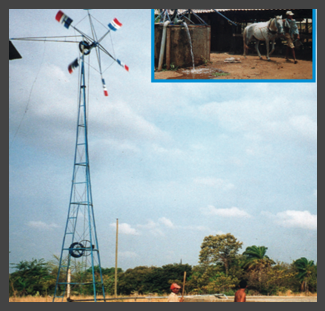Difference between revisions of "Horse and wind powered pumps"
m |
|||
| Line 4: | Line 4: | ||
<b>Wind powered pumps</b> | <b>Wind powered pumps</b> | ||
| + | |||
In several countries, low-cost windmills are used to power piston pumps. Examples include the Miramar mills in Peru, the Poldaw mills in Africa and Baptist mills in Bolivia. | In several countries, low-cost windmills are used to power piston pumps. Examples include the Miramar mills in Peru, the Poldaw mills in Africa and Baptist mills in Bolivia. | ||
| Line 9: | Line 10: | ||
<b>Rural electricity</b> | <b>Rural electricity</b> | ||
| + | |||
As an option, wind rope pumps can be combined with a permanent magnet generator to charge batteries for a few light bulbs and a television. There are also small wind generators based on the design of the wind rope pump. | As an option, wind rope pumps can be combined with a permanent magnet generator to charge batteries for a few light bulbs and a television. There are also small wind generators based on the design of the wind rope pump. | ||
Revision as of 20:27, 29 July 2007
Renewable energy sources such as animal power and wind power can be used to extract water from wells.
Wind powered pumps
In several countries, low-cost windmills are used to power piston pumps. Examples include the Miramar mills in Peru, the Poldaw mills in Africa and Baptist mills in Bolivia.
In Nicaragua, windmills are combined with a rope pump. The wind rope pump has features of a modern wind pump of Dutch design (CWD 2000) and there are 300 units installed in Nicaragua, produced locally and maintained by the users. They are used for cattle watering, domestic water supply and irrigation. A recent survey indicates that the investment in a wind rope pump for irrigation can be recovered within 2-3 years.
Rural electricity
As an option, wind rope pumps can be combined with a permanent magnet generator to charge batteries for a few light bulbs and a television. There are also small wind generators based on the design of the wind rope pump.
| Advantages | Disadvantages |
|---|---|
| Uses renewable energy sources. Can be combined with a permanent magnet generator. |
Capacity
40 litres / min from 10 meters depth.
Costs
- US$ 20-120 depending on model.
Applying conditions
- Numbers: 50,000 in Nicaragua, 20,000 in Mexico, Honduras, Guatemala, Ghana, Zimbabwe, Tanaznia, Senegal.
- Range of depth: 1-35 meter (60 m with two cranks).
- Application Communal wells, houshold, irrigation.
- Cost of introduction: US$ 10,000-20,000 per project, including 20 pumps, engineering and hands-on training. US$ 60,000-100,000 per project, including 1,000 pumps, production workshop and hands-on training.
Rope pump building manual
PRACTICA foundation and the Technical Training Programme of the ETC Foundation (TTP/ETC) have put together a really excellent manual on how to build rope pumps (PDF, 2.5 Mbyte). It is an 86 page long document with detailed instructions.
External links
- Evaluations www.irc.nl
- Africa www.pumpaid.org
- General info www.ropepump.com
- How to build www.ropepumps.org

